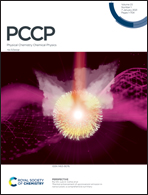The electronic and magnetic properties of h-BN/MoS2 heterostructures intercalated with 3d transition metal atoms
Abstract
We performed density functional theory calculations to investigate the electronic and magnetic properties of h-BN/MoS2 heterostructures intercalated with 3d transition-metal (TM) atoms, including V, Cr, Mn, Fe, Co, and Ni atoms. It was found that metal and magnetic semiconductor characteristics are induced in the h-BN/MoS2 heterostructures after intercalating TMs. In addition, the results demonstrate that h-BN sheets could promote charge transfer between the TMs and the heterogeneous structure. Specifically, the h-BN/MoS2 heterostructure transforms from an indirect semiconductor to a metal after intercalating V or Cr atoms in the interlayers. For Mn, Fe, and Co atoms, the bandgaps of the intercalated heterojunction systems become smaller when the spin polarization is 100% at the highest occupied molecular orbital level. However, the system intercalated with Ni atoms exhibits no spin polarization and non-magnetic character. Strong covalent-bonding interactions emerged between the intercalated TMs and the nearest S atom of the h-BN/MoS2 heterostructure. In addition, the magnetic moments of the TM atoms show a decreasing trend for all the interstitial intercalated heterostructures compared with their free-standing states. These results reveal that h-BN/MoS2 heterostructures with intercalated TMs are promising candidates for application in multifarious spintronic devices.



 Please wait while we load your content...
Please wait while we load your content...